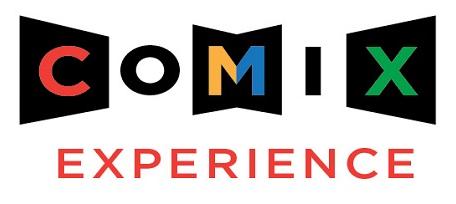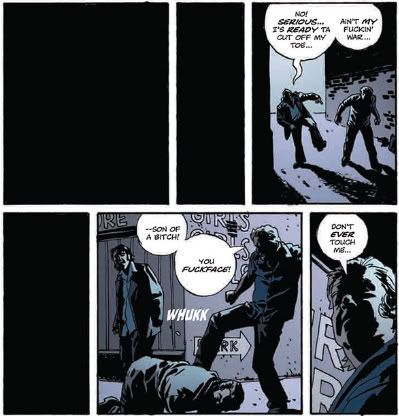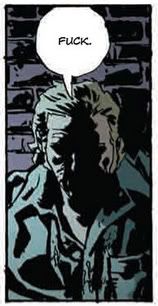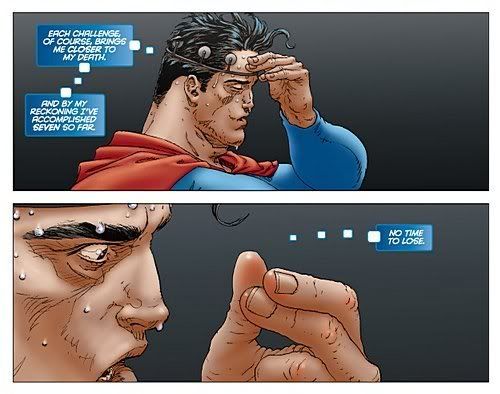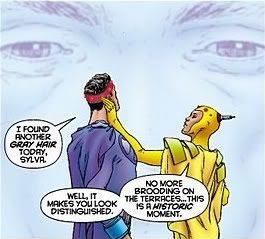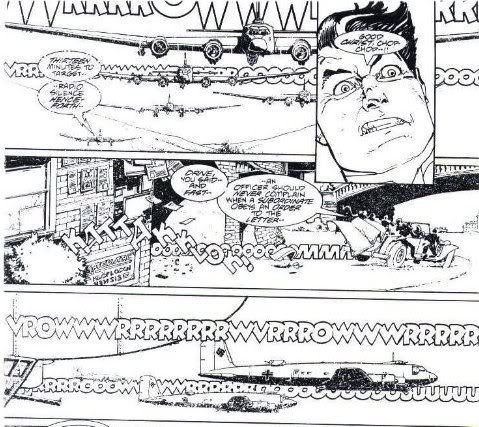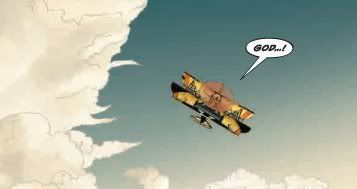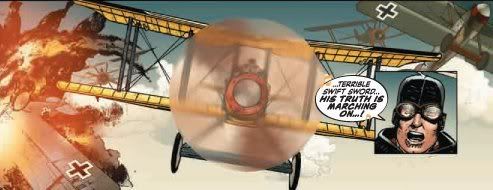 This is the first part of an irregular, multipart series on issues #1 to #25 of the Blue Beetle series published by DC Comics.
The John Rogers "era" of BLUE BEETLE ended recently with issue #25. Keith Giffen had left his position as co-writer of the recently launched book more than a year earlier. Artist Rafael Albuquerque is staying with the book, apparently-- he'd replaced Cully Hamner, the artist who'd launched the series before moving on to some bigger, better deal, if I can accidentally quote the 1984 USA Up All Night shit-fest, HARDBODIES.
This is the first part of an irregular, multipart series on issues #1 to #25 of the Blue Beetle series published by DC Comics.
The John Rogers "era" of BLUE BEETLE ended recently with issue #25. Keith Giffen had left his position as co-writer of the recently launched book more than a year earlier. Artist Rafael Albuquerque is staying with the book, apparently-- he'd replaced Cully Hamner, the artist who'd launched the series before moving on to some bigger, better deal, if I can accidentally quote the 1984 USA Up All Night shit-fest, HARDBODIES.
The overarching origin story that Rogers-Giffen started in issue #1 and drove the first two years of the book also concluded in #25. I hadn't picked up the book until recently. It seems like the book generated a bit of an internet cult for itself-- the DCU's "Best Book You're Not Reading" book. I guess that attracted my attention.
So, I gathered together the first 25 issues the other night, start reading it and blah blah blah: I wasn't that into it. I kept reading for the art; inertia. But then, something changed: issue 22 kicked in-- and the story the creators had plainly wanted to tell the entire time drops.
It's a beaut. The last arc is a goddamn beaut. There's some big-ass, audience-pleasing, fan-service, stomp-Tokyo shit in that arc. It's Return of Barry Allen; it's Rock of Ages; as I believe The Game put it once, "I'm BIG, I'm Cube, I'm Nas, I'm 'Pac, this ain't shit but a warnin' til my album drop." It's not my song, and I'm not a fan of The Game, but the quote seemed apropos.
I'm going to start with some background which I'll mark out, in case anyone who reads this site somehow isn't aware of why the BLUE BEETLE comic exists to begin with. Pretty skippable for most of you, I figure.
BACKGROUND:
The last Blue Beetle character, the second character to bear the name, was a creation of Spiderman co-creator Steve Ditko. He was featured in Keith Giffen and J.M. DeMattheis's light-hearted, character comedy JUSTICE LEAGUE INTERNATIONAL alongside other not-fan-favorites like Fire (aka Green Flame), a deranged violent Green Lantern named Guy Gardner, and most notably, Booster Gold-- Gold and the earlier Blue Beetle formed a comedic duo for the DCU. Following that series, Blue Beetle also had a recurring role in the BIRDS OF PREY series.
Then, in this last decade, DC comics were competing poorly with competitor Marvel Comics-- Marvel had better creators and better characters. DC opted to compete by jolting their readership with a series of short-term "shocks" tied into a series of "must-read-to-understand-the-universe", editor-written crossovers. One of those shocks was having Blue Beetle-- remembered by many to be a comedic character-- having his brains splattered against a wall, as a signal that the DC "universe" would no longer be light-hearted or comedic, but would be... brain-splattery, instead. To assuage the fanbase that this was somehow "meaningful", they arranged for a brand-new Blue Beetle character to be a pivotal character to the concluding crossover in a suite of crossovers (which suite of crossovers preceded the subsequent suite of crossovers, or.. something).
DC's strategy worked for a little while until (a) Marvel followed suit with a series of crossovers that were enormously better, (b) DC seemingly over-invested in a strategy involving weekly comics, (c) the appeal of all this wore off with fans to some nebulous extent, and (d) the overall economy went fucking pear-shaped -- gas costs me $4 goddamn dollars a goddamn gallon, are you fucking kidding me, $4 goddamn dollars a goddamn gallon, goddamn. As of recent reports, DC may be back to where they were before they started all this nonsense, lame second fiddle to a creatively and commercially dominant Marvel Comics (at least by the highly limited and weird standards by which these sort of comics are judged).
END OF BACKGROUND
So, then-- consider the likely goals of the creators at the outset of the series:
(1) Tell a single two-year meta-story that was comprised of smaller story arcs (what TV fans might call the "Buffy" model); (2) launch a new superhero character in a marketplace hostile to new superhero characters; (3) launch an ethnic character to an audience that never supports minority characters; (4) tie into the shitty, oppressive meta-story of the "DC Universe"; (5) remain independent enough of the shitty, oppressive meta-story of the “DC Universe" to convey the book’s own meta-story in a comprehensible way; (6) service a meta-arc while satisfying the demands of monthly fans-- e.g. having a superhero fight every issue; (7) tell a superhero origin story as well as telling a teen coming-of-age story; (8) juggle a superhero cast-- heroes, villains, mentors, etc.-- with a sizable supporting cast for the teen coming-of-age story; (9) place the brand new Blue Beetle character into some kind of larger context visa vi earlier iterations of the Blue Beetle brand name, without angering fans of previous iterations by suggesting those earlier versions were somehow less than the new version, while still allowing said fans to see the new characters as being a worthy inheritor of the brand name;and (10) present an all-ages book that's friendly to new fans looking for a new character to latch onto but also friendly to DCU otaku.
SPOILER WARNING: they fail.
Sales of the new BLUE BEETLE series are in the fucking toilet; BLUE BEETLE chocolate kisses the toilet once a month. Initial orders for issue #22 of BLUE BEETLE were at 15,256 copies (NOTE: the significance of initial orders are a subject of a debate that I completely don't care about). Despite a dedicated internet fan-cult, and two artists producing work superior to most of what the DCU publishes, the series is one of the lowest selling books in the DCU.
The first 25 issues constitute not only a single entire story, but possibly a window into a number of different goals, successes, failures, so... My plan is to re-read the entire series, and see if I can think of anything interesting-ish to say.
Questions to consider: Why have fans rejected this series? What went wrong? Or if nothing went wrong, was there something that had to go "right" that didn't happen? What goes into the crafting and selling of a new superhero character? What goes wrong with new superheros, that so dramatically few catch on with fans? And most of all, why did the ending work? All of these reviews of nerdy shit that gets written week after week-- what do I read for an explanation of why nerdy things work?
Why does the ending work if the beginning so, so didn't? Because it sure doesn't start well...
BLUE BEETLE ISSUE #1:
 Je-sus.
Je-sus.
This inaugural issue juggles two time-lines: a fight between Blue Beetle and the Guy Gardner Green Lantern in the "present", and a lengthy origin sequence set in the "past", setting up how the character received his powers, as well as the character's "secret identity" and supporting cast.
It's a strange place to have to start a new series, where one of the biggest moments in a new superhero comic has been taken away from the creative team. The big "Hello, Blue Beetle; meet the rest of the DCU" moment already happened, and it happened in a different comic. Or if you think about it, the creators were to some extent forced into the dual time-line structure-- an entire issue set prior to the events of the earlier-published crossover comic would have forced them to find a way to play "catchup" with the time-line of the other 900 books DC contemporaneously publishes. The dual time-line's inelegant, and robs the issue of any suspense or momentum, but it's probably preferable to whatever they would have otherwise had to do to keep current with the rest of the publishing line. Especially because DC was about to launch another stunt where such-and-such month was ONE YEAR LATER month, where all the books advanced a year-- something that comes up and causes some pointless havoc in later issues.
But look at that awful scene...
The rest of the scene is a comedy scene, establishing the new Blue Beetle's two best friends, a wisecracking young lady and a wisecracking pudgy friend. Also, Blue Beetle? Wisecracking. Everyone in the Blue Beetle comic sounds like they'd rather be in a Joss Whedon screenplay. For example: wisecracking! But betwixt all the wisecracking, in the midst of the wisecrack, the scene lurches into the following panel...
 As the punchline to a comedy scene.
As the punchline to a comedy scene.
Jesus Crap, look at it. No matter where you are in a room, its eyes... its eyes just follow you. You know, you watch a Joss Whedon thing and you can at least say to yourself, "No one talks like that in real life, but I wish they did. While sitting on my face." But... I don't think you can say that here. I'm personally kind of glad that in real life, people don't make snappy wisecracks about the ritualistic child abuse that they suffer. I like a good snappy wisecrack; I'm pro-wisecrack; I'm just anti-ritualistic-child-abuse. That's what makes me a better person than you.
It's "laying pipe" according to Mr. Rogers's blog-- which is apparently a writer's expression meaning "writing and delivering the onerous dialogue which provids backstory and the plot facts needed to support the weight of the funny (or interesting). Exposition, kids, and it ain't fun." The fact the young lady's dad hits her is very-slightly meaningful to the series later (right this second, I don't even remember the dad ever being seen on-panel).
But: I would rather read a metal pipe. There's good reading on pipes. Hell, I would rather fuck a metal pipe, than... Well, I'd rather a fuck a metal pipe in general. Say goodbye to apologizing for premature ejaculation, and say hello to metal pipes. I have a teddy bear-- that's what it says on its t-shirt. That's why people say "pipe down" when they want you to be quiet-- that expression came from pipe fetishists like me. Because you don't talk dirty when you're fucking a metal pipe. That'd just be weird. "Oh, you're so cylindrical"-- that'd just be creepy. Fuck a pipe in silence. I have a teddy bear-- that's what it says to me when it's not telling me to impress Jodie Foster. Anyways...
Everything about these three panels is wrong.
First, it turns a comedy scene into an afterschool special.
Second, we've known the main character for all of two pages at this point, and the first thing they're telling us about him is that he doesn't care if his friend is getting physically abused by her father. "Oh, your dad savagely beats you? Does he molest you too? That's nice. Well, I'm going to just stand over here and pop my collar and quote The Game lyrics to the sidewalk." Let's read about that guy every month. Look at him-- "my father beats me"-- and he's rolling his eyes!
 "You're talking about the physical abuse again? YAWN." Oh, we could explain it to ourselves-- they don't trust child services, say, so they don't report his abuse despite her obvious pleas for help-- but nothing that supports our explanation ever makes it to the page from what I remember.
"You're talking about the physical abuse again? YAWN." Oh, we could explain it to ourselves-- they don't trust child services, say, so they don't report his abuse despite her obvious pleas for help-- but nothing that supports our explanation ever makes it to the page from what I remember.
Third, it doesn't work on a "does this make sense that character X would say Y" level of -- what, does she want him to punch her, too? Why? Can't she just have her dad double-down on the child abuse, if she's aiming to get punched...? If she wants to get punched, couldn't she just hide his whiskey or sass him during Leno's monologue or...? Or how about a scene where she teaches the other kid how not to leave bruises on any areas where school administrators might see them? How about that?
Fourth, while I love Cully Hamner's art and have since Green Lantern: Mosaic, and his work on this comic is as strong as ever, he doesn't really quite land the "dust the debris off" hand-move in that last panel of the sequence--
 "Oh your dad beats you. Let me play my imaginary turntables. Air DJ competitions are in a week at the Civic Center, the week after Motocross."
"Oh your dad beats you. Let me play my imaginary turntables. Air DJ competitions are in a week at the Civic Center, the week after Motocross."
It took no small amount of effort to keep reading this series.
What's interesting about the moment to me, though, is how it immediately positions the character as being morally compromised. Whatever explanation you can come up with in your head as to why he's not doing anything to help his friend is ultimately a compromise. I think maybe comic fans don't enjoy Figures of Compromise. For most of their history, superhero characters are these power fantasies about not having to compromise-- the X-Men fight for a dream; you can't compromise on a dream. Spiderman-- "great responsibility" and compromise, to some extent, seem incompatible to me. Compromise-- most of the recent events which have gotten fans the most upset have been compromises. Iron Man compromises and he's considered a villain to comic fans. Spiderman compromises that one time, and fans freak the fuck out.
Or not just comic fans, but people in general-- consider the Great Heroes of Western Civilization. Not a lot of compromise gets celebrated.
Winston Churchill: "We shall go on to the end, we shall fight in France, we shall fight on the seas and oceans, we shall fight with growing confidence and growing strength in the air, we shall defend our Island, whatever the cost may be, we shall fight on the beaches, we shall fight on the landing grounds, we shall fight in the fields and in the streets, we shall fight in the hills; we shall never surrender, and even if, which I do not for a moment believe, this Island or a large part of it were subjugated and starving, then our Empire beyond the seas, armed and guarded by the British Fleet, would carry on the struggle, until, in God's good time, the New World, with all its power and might, steps forth to the rescue and the liberation of the old."
Or Mike Tyson: "I'll fuck you till you love me."
 The issue then concludes with, inter alia, this bit. The second panel, assuaging the otaku that Blue Beetle connects to some greater whole, is a reference to the character's introduction in the earlier crossover. Just an incomprehensible chunk jammed into the second-to-last panel without any explanation provided to any potential new readers, even a "See Issue ___" editorial caption since those are out-of-fashion. You know: probably not the best choice, that.
The issue then concludes with, inter alia, this bit. The second panel, assuaging the otaku that Blue Beetle connects to some greater whole, is a reference to the character's introduction in the earlier crossover. Just an incomprehensible chunk jammed into the second-to-last panel without any explanation provided to any potential new readers, even a "See Issue ___" editorial caption since those are out-of-fashion. You know: probably not the best choice, that.
What's interesting to me about this scene is... you know, the great superheros, you can kind of boil down the appeal of that character to one word. Spiderman: perseverance, say. Hulk: anger. Captain America: patriotism. Thor: mythology. Iron Man: technology. Tinky-Winky: gayness. That's what those characters are fundamentally about.
What is this new Blue Beetle character about? Fundamentally about?
After the first issue, could a reader answer that question?
It's not about BEETLES. The above panels perhaps suggests its about alienation, but the rest of the comic doesn't support that idea-- the Blue Beetle character has friends and a family that he loves. He's hardly alienated.
I suppose... The 25 issues as a whole are a coming of age story-- like any coming of age story, it's about a young boy becoming a man, and entering the larger, cooler, scarier, world of adulthood. Same as Star Wars or whatever. Hell, the first issue even ends with him on a cliff looking out into that world-- it's not subtle. But that's...
First, I don't really think that's effectively communicated in the first issue. It's jammed into a few panels in the last page of the first issue. Second, it's a limited story-- at the end of 25 issues, that story is done. It's not enough to hang a series on, or at least-- I think it's got a time limit on it. Third, it answers the question for the series, perhaps, but not for the character. When Thor fights Iron Man, that's mythology and technology clashing regardless of which book it's happening in. How much does that matter? It's hard to say. Fourth, well ... I don't know. "Blue Beetle is about liminality." Thanks, college boy. You know? It's not obvious on its face, the way the appeal of other superhero characters often is (e.g., Doctor Strange, you just need to hear his name and the appeal is apparent).
So: not an auspicious beginning no, but it does get better...
